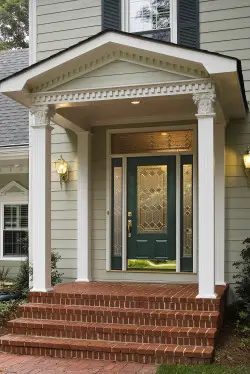How do you know that it is time to replace your front door? It seems nowadays that people don’t use their front door as much as they use to. With garage entries and side doors, most of us don’t even think about our front doors.
The problem is most of us nowadays understand that we need to replace our old single-pane, non-energy efficient windows, but most of us don’t consider our doors. If your home has a foyer or staircase leading directly to your front door, your heating and cooling are being wasted more than the average home without a foyer.
If you are interested in learning about our energy-efficient and beautiful front entry doors, click here or call 978-817-7072 to get in touch with us.
Here are 7 ways you can check to see if it’s time for your home to have its old leaky door entryway replaced.
1. Does your daily workout consist of simply trying to open and close the front door?
If your door is difficult to open and close, it may be time to replace it. When you feel your door sticking in the winter and easy to open and close in the summer, that’s a sure sign of energy rushing out your door. If the hinges are sinking, that’s another issue. But if its sticking into the door jam, your door probably has exposed areas either down the sides or top or bottom where you can see light.
Seeing light from the inside or outside without the door being open is a problem. If you take a lighter a couple inches around those edges, pay attention to what the flame does. It will try to move right outside the door. This indicates leaking air.
2. Does your door have more dings and rust than a junkyard car?
Dings and rust on a door show its structure may be weak. Most store-bought doors use thin steel over wood frames. These doors typically use 24- to 26-gauge steel, which lacks durability. They barely meet residential standards for strength and safety. Now, picture this—you just returned home after a long grocery trip. You pop your trunk, ready to unload. You’d rather make one trip than ten, right? So, you stack five bags on each arm, both hands full.
As you reach your front door, you give it a little kick to open it. Suddenly, you notice a large dent. If a light kick dents the door, can it really protect your home from force? If the door shows rust, moisture might be seeping into the frame. That could weaken it from the inside. Even beyond energy efficiency, that’s not the kind of door I’d trust for home security.
3. Does your front door have moisture between the panes of glass?
Just like new windows, a lot of doors with glass packages have double-paned glass. Over time with older doors, the seal between those two panes will fail to lead to moisture, mildew and/or mold between the panes of glass. This is a scary thing to see in a door. With windows, some people let it go longer than they should because their windows are made of inorganic materials which makes it easier to prolong the amount of time needed to replace the window because there is no fear of mold or mildew spreading to the rest of the home.
When it comes to your front door, the urgency to replace must be much quicker. Until the past 10 years, all residential doors have had a wood core or frame. If you have seal failure between your door’s glass panes, the mold/mildew are surrounded by organic material. Especially if your entryway is shaded or doesn’t receive much direct sunlight, this can be a huge problem. The last thing any homeowner wants to hear is mold remediation. Just like the windows in your home, when you have a door with moisture between the panes of glass, it’s time to replace it.
4. Is your door weathered, warped, or cracked terribly?
Doors can take a beating over their lifetime. People slam and kick them, and they endure huge temperature changes. If you have an old solid wood door, it has probably seen better days. Many winters and summers cause doors to expand and contract, resulting in cracks, warping, and severe weathering over time.
When you inspect your old wooden door, treat it like a door that is difficult to open. Look for light coming into the room from the “solid” wood door. Many of these doors have stress fractures in the grains of the door. These stress fractures expose the outside elements to the inside of your home or vice-versa.
5. Do you stuff a towel under your door to keep the freezing weather out of your home?
If this is the case, you get credit for effort—you’ve identified the problem. However, there’s a better way to keep energy inside your home without ruining your favorite towels. You don’t have to replace the entire door. Many doors today feature a spring-loaded threshold that can improve the seal. Look at your threshold and check for screws on the surface. If you see three or four screws, you might be able to raise it. This adjustment could help the threshold meet your weatherstripping and stop the draft.
If raising the threshold doesn’t help, or the weatherstripping is too old, you can replace it. We recommend a triple fan sweep for the best results. Most hardware stores carry this type of weatherstripping, and installation takes less than 10 minutes. This simple fix saves money, boosts comfort, and keeps your treasured towels from blocking door drafts. A quick upgrade like this offers major comfort and efficiency gains for your home.
6. Have you had water damage or insect damage in the past?
If you have water damage, you know that the wood has to be replaced. Most people with this problem know that if the wood is breaking apart and soft, its not secure enough to support the door structure or to keep your home safe. Obviously, you must replace your entry door if this is a problem you’ve had. The same thing applies with insect damage.If you’re in need of a replacement, consider exploring Entry Doors in Gloucester, MA to find the perfect solution for your home.
If your exterminator says 50% of the wood is damaged, your door’s R-Value has dropped significantly. This damage makes your home easier to break into and invites moisture or insects to cause further harm. It also wastes heating and cooling energy. When a door loses R-Value, it weakens your home’s thermal barrier—unless it’s a full-glass door. In that case, you must replace it. Do people compliment your retro door, even when that’s not the style you want?
Style Matters: Is Your Door Sending the Right Message?
When it comes to your door, aesthetics are extremely important. Realtor.com and Remodeling Magazine both say that beyond your roof and landscaping, the front door is the first thing that prospective buyers either compliment or hate when they’re showing a home. Let’s face it, styles change dramatically every 10-20 years, if not sooner. Many of us can’t believe the clothes we wore, as seen when looking through our high school yearbooks.
Sometimes, just like our dramatic Aquanet up-dos and unhooked overalls, people take dramatic approaches with their homes too. Front doors seem to take the most abuse when referring to our dramatic style choices.
There is a good reason why too. The front door sets the tone for the entire experience of the home. One could say that it’s a person’s first impression of a home. If you have classic shakes/wood siding, beautiful true grids on your windows, classic landscaping all around, it’s probably time to get rid of that 3 diagonal glass flat 1970’s door. Replacing your front door can be one of the biggest bang-for-your-buck investments that you can buy to improve your home. You can increase your energy efficiency while adding dramatic beauty to your curb appeal. If you’re wondering if today is the day to replace your entry door, ask yourself the questions above.
If you decide it’s time to replace your front door, we can help. Click here or call 978-817-7072 for help determining the best front entry door for your home. Like always, it’s your number one investment, take care of your home with a beautiful, quality front entryway.
Take a Look at the Vintage Door You’ve Always DREAMED Of (with the Technology You Need!)





